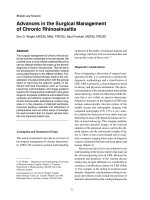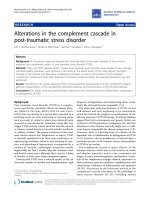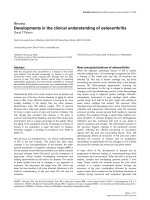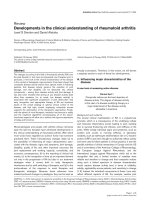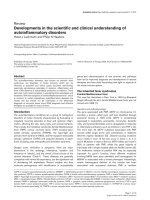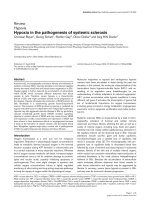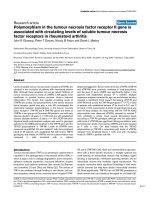Báo cáo y học: "Termites in the woodwor" potx
Bạn đang xem bản rút gọn của tài liệu. Xem và tải ngay bản đầy đủ của tài liệu tại đây (182.26 KB, 4 trang )
Genome Biology 2007, 8:229
Minireview
Termites in the woodwork
Samuel Chaffron and Christian von Mering
Address: Institute of Molecular Biology and Swiss Institute of Bioinformatics, University of Zurich, Winterthurerstrasse, 8057 Zurich,
Switzerland.
Correspondence: Christian von Mering. Email:
Published: 22 November 2007
Genome Biology 2007, 8:229 (doi:10.1186/gb-2007-8-11-229)
The electronic version of this article is the complete one and can be
found online at />© 2007 BioMed Central Ltd
Most animals, from insects to mammals, carry complex
communities of microbes in their digestive tracts. In the
case of wood-eating termites, these gut microbes are
particularly important: they are thought to provide most of
the capabilities needed for efficient digestion of wood,
which is otherwise a largely inaccessible food source. They
also help to compensate for the paucity of some nutrients
in wood, for example by fixing atmospheric nitrogen, and
they synthesize essential amino acids and other
compounds for their hosts [1,2].
Despite their importance, relatively little is known about gut
microbes in termites. This is partly because gut microbes are
often difficult to grow in pure culture (as is the case for most
microbes sampled from natural environments).
Furthermore, a single termite can harbor a very complex
assemblage of hundreds of different microbial lineages,
whose members may vary widely in terms of abundance and
growth rates. Without access to cultivated strains,
researchers have to rely on so-called 'cultivation-
independent' molecular techniques to analyze such
communities. A clever combination of these techniques has
now been applied to a section of the termite hindgut, aiming
to identify molecular tools used by the microbes in this
compartment to degrade wood [3]. Here, we review the
procedures and results of this study, and discuss insights
into the biological system as well as implications for the
generation of biofuels.
A comprehensive inventory
As recently as 2004, biologists had rather limited
experimental options for taking stock of uncultured
microbes in their natural environments. They could analyze
selected phylogenetic marker genes to assess taxonomic
identity (using in situ hybridization or PCR-based
sequencing), or they could use expression cloning to screen
for genes encoding a specific activity of interest. Another
possibility was to clone and sequence individual DNA
fragments isolated from the community, in the hope of
finding phylogenetic marker genes and important functional
genes together on the same fragment: this latter approach
can help to map lifestyles to a given lineage [4,5]. However,
none of these strategies simultaneously provides a global
inventory of both the taxonomic and the functional
properties of a microbial community.
To overcome this limitation, researchers have since begun to
apply genomics (and proteomics) technologies in high-
throughput mode, analyzing entire microbial assemblages
without first cloning individual strains [6-9]. These exciting
new research approaches ('environmental genomics',
'metagenomics' and 'metaproteomics') put the possibility of
a molecular description of an entire microbial community
within reach for the first time. For the termite gut ecosystem,
Warnecke and colleagues [3] have now attempted just that,
in a formidable tour de force. They even went a step further
by complementing their work with a preliminary
Abstract
Termites eat and digest wood, but how do they do it? Combining advanced genomics and proteomics
techniques, researchers have now shown that microbes found in the termites' hindguts possess just
the right tools.
biochemical analysis of some of the enzymes they
discovered.
The team began by sampling the luminal contents of the P3
hindgut segment, pooling the material from 165 adult
worker termites. This is the largest of the gut compartments,
yet still contains only about 1 µl of material (Figure 1). From
this material, the authors purified the genomic DNA,
fragmented, subcloned and sequenced it. They generated
about 70 megabases (Mb) of raw shotgun sequence and also
selected several fosmid inserts to be sequenced separately
for more detailed inspection. Warnecke et al. [3] mainly
used classical capillary sequencing; today, this technology is
being rapidly surpassed and the next-generation sequencing
technologies will increase the scope of such studies by orders
of magnitude [10]. As is the case for most metagenomics
projects, the shotgun reads could not be assembled into
complete genomes. In fact, relatively little assembly was
possible at all - the longest assembled contig encompasses a
mere 14.7 kb - owing to the complexity of the microbial
community.
The metagenomics sequencing effort was complemented by
a more focused strategy to sample a single phylogenetic
marker gene (using PCR amplification and cloning of 16S
ribosomal RNA genes). These 16S sequences were combined
with similar sequences from the shotgun approach and
analyzed in order to ask the question: which phyla and how
many species are present in the termite gut?
As previously reported, members of the bacterial phyla
Spirochaetes and Fibrobacteres dominated the community.
Notably, Warnecke et al. [3] did not detect any archaeal
sequences, nor did they find much eukaryotic material
(there was apparently very little contaminating DNA from
the host, if any). They discovered 216 distinct 'phylotypes' of
bacteria (that is, groups of 16S sequences with at least 99%
sequence identity) and estimated from the redundancy in
these phylotypes that what they had found represented
about 70-90% of the total diversity. This is roughly similar to
the diversity of the human gut microbial flora [11].
Apart from a phylogenetic characterization, the authors
carried out a quantitative analysis of functional genes in
the sample. They focused on certain categories of interest:
how many genes would encode enzymes known to degrade
cellulose, xylan or lignin? Would there be evidence for
nitrogen fixation? To find out, the authors grouped the
predicted genes into families and orthologous groups,
annotated them, and compared the abundance of each
gene family to the respective occurrences of these genes in
other environments, such as soil [7], seawater [6] or the
human gut [12].
First and foremost, they found a large number of glycoside
hydrolases; that is, enzymes that can degrade
polysaccharides. The authors classified these genes
according to known sequence families and predicted
substrates, and attempted to assign them to the most likely
source organism. Forty-five distinct groups were detected,
and composition-based analysis predicted Treponema (a
genus of Spirochaetes) as the most likely origin for the
majority of these enzymes. In addition, a number of gene
families known to associate with glycoside hydrolase
Genome Biology 2007, Volume 8, Issue 11, Article 229 Chaffron and von Mering 229.2
Genome Biology 2007, 8:229
Figure 1
Exploring the termite hindgut. (a) Photograph of a worker termite from
the genus Nasutitermes. (b) The gut contents from the third proctodeal
segment (P3) were sampled, and analyzed using a variety of techniques.
(c) Three-dimensional structures of two typical cellulase enzymes (left,
PDB1ksd; right, PDB1f9d). Photograph: CSIRO.
1 mm
Hindgut P3
Collect and lyse bacteria
Typical cellulase enzymes
(Nasutitermes takasagoensis)(Clostridium cellulolyticum)
Produced by a termite Produced by a bacterium
•
establish the taxonomic identities of bacteria
•
describe the inventory of genes (coding potential)
•
identify which proteins are actually produced
Assess activity of selected enzymes
Sequence the DNA material (metagenomics)
Demonstrate gene expression (proteomics)
•
validate DNA sequencing - sufficient coverage?
•
establish optimal incubation conditions
•
confirm predicted substrates
(a)
(b)
(c)
domains were found, including carbohydrate-binding
domains and other functional domains. In total, hundreds of
new enzymes were described, many of which significantly
extend our knowledge of the various enzyme families.
Remarkably, no enzymes were found for the degradation of
lignin, a major constituent of wood that is partly responsible
for its strength. Some enzymes capable of lignin degradation
have previously been described, but none of these was found
among the sequences retrieved here. Of course, as yet
undescribed enzymes could do the task, or this activity could
be located in a different compartment of the termite gut. The
latter might well be the case, as many of the enzymes known
to degrade lignin require molecular oxygen and the P3
segment is largely anoxic.
As expected, several other functional processes known (or
suspected) to be carried out by the gut microbes were
represented among the sequences. These include nitrogen
fixation, chemotaxis and chemosensation, as well as carbon
fixation from carbon dioxide via the Wood-Ljungdahl
pathway [13].
Metaproteomics and activity assays
The detection of an open reading frame alone does not
suffice to show that the protein is actually made, nor does it
readily indicate when and where the gene is expressed. To
assess the more abundant proteins at least, mass
spectrometry is a promising tool, provided that the
community is not too complex and it has been sampled
deeply enough at the nucleotide level [9].
Warnecke and co-workers [3] have focused on a particular
subset of the proteome (the secreted extracellular proteins)
by analyzing centrifuged and clarified P3 luminal fluid using
mass spectrometry. Although they were able to detect only a
relatively small fraction of the expected proteins, they
confirmed for the first time that bacterial glycosidases are
indeed produced in the termite gut. What is more, they
actually demonstrated activity for a number of these
enzymes. More than 40 of the glycosidase genes were
individually cloned, expressed heterologously and tested on
acid-solubilized and microcrystalline cellulose. Although this
is unlikely to match the situation in which these genes work
in vivo, it shows convincingly that termite guts harbor
secreted functional glycosidase enzymes.
Who encodes what?
The most pressing question in any metagenomics analysis is
to what extent the molecular functions identified can be
assigned to particular microbial lineages. This information is
still almost entirely lacking for all but the simplest microbial
communities, but it is crucially important for any deeper
understanding of the ecology of these assemblages. The
problem remains largely unsolved: in the current study [3],
compositional analysis of the DNA provided classification
for only 9% of the contigs beyond the phylum level, leading
to uncertainties; for example, none of the nifH nitrogen-
fixation genes could be assigned. Even where it does work,
compositional analysis is probably not very reliable, as
microbial genomes can harbor large stretches of recently
acquired genetic material, which may not yet have
equilibrated with the host genome. For individual genes of
interest, clever use of coupled PCR reactions has recently
shown a way to reliably map genes to their host genomes
[14], but for a global solution we will probably have to wait
for single-cell sequencing [15].
One of the most intriguing results of this study actually
concerns a class of proteins to which no molecular function
can be assigned so far. Warnecke et al. [3] identified a
number of previously uncharacterized protein families that
were strongly enriched compared with other metagenomes,
and that were in some cases even quite specific to the termite
gut microbes. This is exciting because the degradation of
lignocellulose in most cases requires not just individual
enzymes operating in isolation, but large macromolecular
complexes that guide and coordinate the process. These
complexes have been termed 'cellulosomes' and are
(partially) known for a number of microbial species [16].
Scaffold proteins and accessory proteins may, however, be
different from lineage to lineage, and this could mean that a
number of unknown cellulosome-like proteins are contained
in the specifically enriched proteins discovered in this study.
As an aside, we hope that the success of the gene-based
approaches illustrated here and elsewhere will not deter
those who seek to characterize individual microbial lineages
more thoroughly. Isolating and growing microbes in pure
culture remains an art, and one that continues to produce
ground-breaking insights [17-19]. It provides unequivocal
anchors for taxonomists and for functional studies, and
allows access to the slow-growing, rare community members
that can contribute essential functions. Comparative
genomicists depend on a continued input of high-quality,
well annotated genome sequences to sort out phylogeny and
to understand the effects of horizontal gene transfers and
other evolutionary phenomena. It is to be hoped that those
who produce isolates and complete genome sequences will
continue to be given appropriate credit for their work.
Wood as a source of biofuel
Can the results of this study help us make better use of wood
as a fuel? Humans have used wood as an energy source for
thousands of years, mostly for domestic heating and
cooking. But it has also been used to generate power, for
example in steam engines and occasionally by converting it
to fuel for use in combustion engines (Figure 2). Conversion
of wood into a biofuel, such as ethanol, is again a hot topic
[20,21] because of its potential for at least partially replacing
Genome Biology 2007, Volume 8, Issue 11, Article 229 Chaffron and von Mering 229.3
Genome Biology 2007, 8:229
fossil fuels in transportation and thereby lowering
greenhouse gas emissions.
Unlike some first-generation biofuels derived from just a
small, energy-rich part of the plant (such as the seeds),
which have been criticized on environmental grounds [22],
wood-based biofuels use almost the whole plant. Trees in
particular seem suitable for biofuel production, as they can
be grown on marginal soils with very little water or fertilizer
and do not compete with food crops.
Today, wood conversion is being attempted on the industrial
scale using biotechnology. Cellulases and hemicellulases are
already being used in this process and these enzymes can be
further optimized. Many bigger challenges remain: how best
to deal with the lignin, how best to pre-treat the wood and
how to more efficiently release all sugars for fermentation.
As termites achieve all of that in a volume of 1 µl, and at
ambient temperatures, it seems that we have a lot to learn
from them. It would be very satisfying if basic research into
termite physiology could ultimately end up helping us to
make better, environmentally friendly fuels.
Acknowledgements
The authors acknowledge support from the University of Zurich, through
its research priority program 'Systems Biology and Functional Genomics'.
References
1. Breznak JA, Brune A: Role of microorganisms in the digestion
of lignocellulose by termites. Annu Rev Entomol 1994, 39:453-487.
2. Lilburn TG, Kim KS, Ostrom NE, Byzek KR, Leadbetter JR, Breznak
JA: Nitrogen fixation by symbiotic and free-living
Spirochaetes. Science 2001, 292:2495-2498.
3. Warnecke F, Luginbühl P, Ivanova N, Ghassemian M, Richardson TH,
Stege JT, Cayouette M, McHardy AC, Djordjevic G, Aboushadi N, et
al.: Metagenomic and functional analysis of hindgut micro-
biota of a wood-feeding higher termite. Nature 2007, 450:560-
565.
4. Beja O, Aravind L, Koonin EV, Suzuki MT, Hadd A, Nguyen LP,
Jovanovich SB, Gates CM, Feldman RA, Spudich JL, et al.: Bacterial
rhodopsin: evidence for a new type of phototrophy in the
sea. Science 2000, 289:1902-1906.
5. Treusch AH, Leininger S, Kletzin A, Schuster SC, Klenk HP, Schleper
C: Novel genes for nitrite reductase and Amo-related pro-
teins indicate a role of uncultivated mesophilic crenar-
chaeota in nitrogen cycling. Environ Microbiol 2005, 7:1985-1995.
6. Venter JC, Remington K, Heidelberg JF, Halpern AL, Rusch D, Eisen
JA, Wu D, Paulsen I, Nelson KE, Nelson W, et al.: Environmental
genome shotgun sequencing of the Sargasso Sea. Science
2004, 304:66-74.
7. Tringe SG, von Mering C, Kobayashi A, Salamov AA, Chen K, Chang
HW, Podar M, Short JM, Mathur EJ, Detter JC, et al.: Comparative
metagenomics of microbial communities. Science 2005,
308:554-557.
8. Tyson GW, Chapman J, Hugenholtz P, Allen EE, Ram RJ, Richardson
PM, Solovyev VV, Rubin EM, Rokhsar DS, Banfield JF: Community
structure and metabolism through reconstruction of micro-
bial genomes from the environment. Nature 2004, 428:37-43.
9. Ram RJ, Verberkmoes NC, Thelen MP, Tyson GW, Baker BJ, Blake
RC, 2nd, Shah M, Hettich RL, Banfield JF: Community proteomics
of a natural microbial biofilm. Science 2005, 308:1915-1920.
10. Ryan D, Rahimi M, Lund J, Mehta R, Parviz BA: Toward nanoscale
genome sequencing. Trends Biotechnol 2007, 25:385-389.
11. Eckburg PB, Bik EM, Bernstein CN, Purdom E, Dethlefsen L, Sargent
M, Gill SR, Nelson KE, Relman DA: Diversity of the human
intestinal microbial flora. Science 2005, 308:1635-1638.
12. Gill SR, Pop M, Deboy RT, Eckburg PB, Turnbaugh PJ, Samuel BS,
Gordon JI, Relman DA, Fraser-Liggett CM, Nelson KE: Metage-
nomic analysis of the human distal gut microbiome. Science
2006, 312:1355-1359.
13. Graber JR, Breznak JA: Physiology and nutrition of Treponema
primitia, an H2/CO2-acetogenic Spirochaete from termite
hindguts. Appl Environ Microbiol 2004, 70:1307-1314.
14. Ottesen EA, Hong JW, Quake SR, Leadbetter JR: Microfluidic
digital PCR enables multigene analysis of individual environ-
mental bacteria. Science 2006, 314:1464-1467.
15. Lasken RS: Single-cell genomic sequencing using multiple dis-
placement amplification. Curr Opin Microbiol 2007, 10:510-516.
16. Doi RH, Kosugi A: Cellulosomes: plant-cell-wall-degrading
enzyme complexes. Nat Rev Microbiol 2004, 2:541-551.
17. Giovannoni SJ, Tripp HJ, Givan S, Podar M, Vergin KL, Baptista D,
Bibbs L, Eads J, Richardson TH, Noordewier M, et al.: Genome
streamlining in a cosmopolitan oceanic bacterium. Science
2005, 309:1242-1245.
18. Giraud E, Moulin L, Vallenet D, Barbe V, Cytryn E, Avarre JC, Jaubert
M, Simon D, Cartieaux F, Prin Y, et al.: Legumes symbioses:
absence of Nod genes in photosynthetic bradyrhizobia.
Science 2007, 316:1307-1312.
19. Waters E, Hohn MJ, Ahel I, Graham DE, Adams MD, Barnstead M,
Beeson KY, Bibbs L, Bolanos R, Keller M, et al.: The genome of
Nanoarchaeum equitans: insights into early archaeal evolu-
tion and derived parasitism. Proc Natl Acad Sci USA 2003,
100:12984-12988.
20. Wyman CE: What is (and is not) vital to advancing cellulosic
ethanol. Trends Biotechnol 2007, 25:153-157.
21. Hahn-Hagerdal B, Galbe M, Gorwa-Grauslund MF, Liden G, Zacchi G:
Bio-ethanol - the fuel of tomorrow from the residues of
today. Trends Biotechnol 2006, 24:549-556.
22. Pimentel D, Patzek T, Cecil G: Ethanol production: energy, eco-
nomic, and environmental losses. Rev Environ Contam Toxicol
2007, 189:25-41.
Genome Biology 2007, Volume 8, Issue 11, Article 229 Chaffron and von Mering 229.4
Genome Biology 2007, 8:229
Figure 2
Making fuel from wood. The photograph, taken in 1951, shows a Russian
automobile fitted with a 'wood gasifier' (arrow). Similar vehicles were
relatively widespread in Europe in the 1940s and 50s, and achieved
conversion efficiencies of roughly 3 kg of wood consumed per power-
output equivalent to 1 liter of gasoline. Modern biotechnological
approaches, using enzymes like the ones found in termite guts, are still
struggling to surpass that efficiency [20]. But they do offer a much more
convenient and clean fuel product, ethanol.


